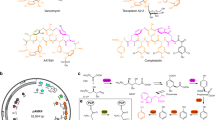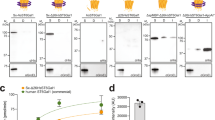Abstract
In nature, the attachment of sugars to small molecules is often used to mediate targeting, mechanism of action and/or pharmacology. As an alternative to pathway engineering or total synthesis, we report a useful method, in vitro glycorandomization (IVG), to diversify the glycosylation patterns of complex natural products. We have used flexible glycosyltransferases on nucleotide diphosphosugar (NDP-sugar) libraries to generate glycorandomized natural products and then applied chemoselective ligation to produce monoglycosylated vancomycins that rival vancomycin.
This is a preview of subscription content, access via your institution
Access options
Subscribe to this journal
Receive 12 print issues and online access
$209.00 per year
only $17.42 per issue
Buy this article
- Purchase on Springer Link
- Instant access to full article PDF
Prices may be subject to local taxes which are calculated during checkout


Similar content being viewed by others
References
Weymouth-Wilson, A.C. Nat. Prod. Rep. 14, 99–110 (1997).
Thorson, J.S. et al. Curr. Org. Chem. 5, 139–167 (2001).
Mendez, C. & Salas, J.A. Trends Biotechnol. 19, 449–456 (2001).
Nicolaou, K.C., Boddy, C.N., Brase, S. & Winssinger, N. Angew. Chem. Int. Ed. 38, 2096–2152 (1999).
Hubbard, B.K. & Walsh, C.T. Angew. Chem. Int. Ed. 42, 730–765 (2003).
Solenberg, P.J. et al. Chem. Biol. 4, 195–202 (1997).
Losey, H.C. et al. Biochemistry 40, 4745–4755 (2001).
Losey, H.C. et al. Chem. Biol. 9, 1305–1314 (2002).
Thorson, J.S., Barton, W.A., Hoffmeister, D., Albermann, C. & Nikolov, D.B. Chembiochem. (in press).
Hang, H.C. & Bertozzi, C.R. Acc. Chem. Res. 34, 727–736 (2001).
Kolb, H.C., Finn, M.G. & Sharpless, K.B. Angew. Chem. Int. Ed. 40, 2004–2021 (2001).
Nicolaou, K.C. et al. Chem. Eur. J. 7, 3798–3823 (2001).
Hlasta, D.J. & Ackerman, J.H. J. Org. Chem. 59, 6184–6189 (1994).
Wang, Q. et al. J. Am. Chem. Soc. 125, 3192–3193 (2003).
Ge, M. et al. Science 284, 507–511 (1999).
Acknowledgements
We gratefully acknowledge the University of Wisconsin-Madison School of Pharmacy Analytical Facility for LC-MS support (Gary Girdaukas) and Christopher T. Walsh and Heather Losey for graciously providing the glycosyltransferase E expression strain. J.S.T. is an Alfred P. Sloan Research Fellow. This work was supported in part by the US National Institutes of Health (GM58196, CA84374 and AI52218).
Author information
Authors and Affiliations
Corresponding author
Ethics declarations
Competing interests
The authors declare no competing financial interests.
Supplementary information
Rights and permissions
About this article
Cite this article
Fu, X., Albermann, C., Jiang, J. et al. Antibiotic optimization via in vitro glycorandomization. Nat Biotechnol 21, 1467–1469 (2003). https://doi.org/10.1038/nbt909
Received:
Accepted:
Published:
Issue Date:
DOI: https://doi.org/10.1038/nbt909



